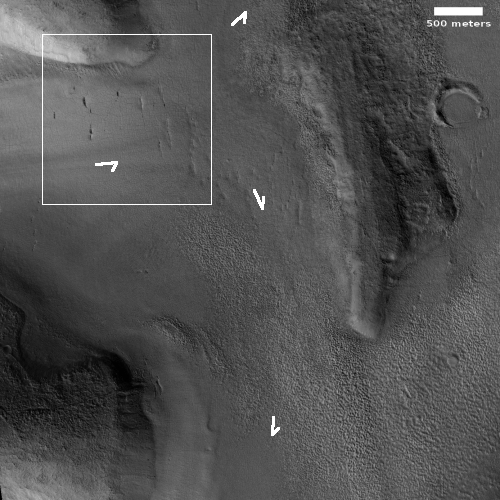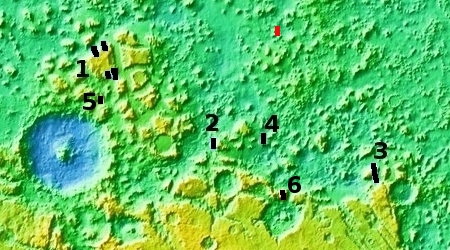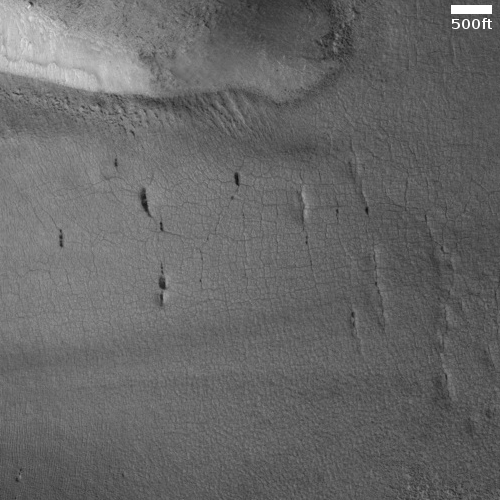A cracking Martian glacier?
Cool image time! The photo to the right, cropped to post here, was taken on December 4, 2020 by the high resolution camera on Mars Reconnaissance Orbiter (MRO)
I have cropped it to show at full resolution the area that contains what the scientists apparently consider the most interesting feature in this image, which they have labeled as “pits forming lines.” These are the vertical cracks and strings of holes that can be seen in this glacier-like flow. In addition, you can see that the cracking is not just vertical, but also extends out in horizontal directions, though the widest cracks are all vertical.
The next image below, which is a lower resolution crop of the full photo, shows a wider view to provide a better picture of the glacier itself.


The white box marks the area covered by the first photo above. The white arrows indicate my guess of the downhill flow direction of this apparent glacier, which seems to split at the eastern mesa into northeastern and southern flows.
The red box in the overview map below marks the location of this glacier, in the northern part of the chaos region dubbed Protonilus Mensae that is also part if what I have dubbed Mars’ mensae glacier country.
The numbered black boxes indicate cool images in this region that I have previously featured:
- 1. Buried glaciers flowing off of Martian mesa
- 2. Brain Terrain on Mars
- 3. How to spot a glacier on Mars
- 4. Glacier country on Mars
- 5. Revisiting Mars’ glacier country
- 6. Back to Mars’ glacier country
So, why the cracks? My guess is that at some time when this glacier was flowing (which is probably not now), the flow rate in this section was faster than the deposition rate of ice, so the glacier started to spread, producing the cracks. The vertical cracks, perpendicular to the flow, were pulled apart, and thus produced the holes. The horizontal cracks, parallel to the flow, were merely elongated which is why they are not as wide.
It is also possible that this ice might less protected by dust and debris, so that it is now sublimating away, thus causing these holes and cracks to widen with time.
The photo illustrates again why I call this Mars’ glacier country. Every photo of every mesa you see in the overview map has similar glacier-like features. There is a lot of buried ice in this region on Mars, all there for future explorers to mine to their heart’s content.
On Christmas Eve 1968 three Americans became the first humans to visit another world. What they did to celebrate was unexpected and profound, and will be remembered throughout all human history. Genesis: the Story of Apollo 8, Robert Zimmerman's classic history of humanity's first journey to another world, tells that story, and it is now available as both an ebook and an audiobook, both with a foreword by Valerie Anders and a new introduction by Robert Zimmerman.
The print edition can be purchased at Amazon or from any other book seller. If you want an autographed copy the price is $60 for the hardback and $45 for the paperback, plus $8 shipping for each. Go here for purchasing details. The ebook is available everywhere for $5.99 (before discount) at amazon, or direct from my ebook publisher, ebookit. If you buy it from ebookit you don't support the big tech companies and the author gets a bigger cut much sooner.
The audiobook is also available at all these vendors, and is also free with a 30-day trial membership to Audible.
"Not simply about one mission, [Genesis] is also the history of America's quest for the moon... Zimmerman has done a masterful job of tying disparate events together into a solid account of one of America's greatest human triumphs."--San Antonio Express-News
Cool image time! The photo to the right, cropped to post here, was taken on December 4, 2020 by the high resolution camera on Mars Reconnaissance Orbiter (MRO)
I have cropped it to show at full resolution the area that contains what the scientists apparently consider the most interesting feature in this image, which they have labeled as “pits forming lines.” These are the vertical cracks and strings of holes that can be seen in this glacier-like flow. In addition, you can see that the cracking is not just vertical, but also extends out in horizontal directions, though the widest cracks are all vertical.
The next image below, which is a lower resolution crop of the full photo, shows a wider view to provide a better picture of the glacier itself.


The white box marks the area covered by the first photo above. The white arrows indicate my guess of the downhill flow direction of this apparent glacier, which seems to split at the eastern mesa into northeastern and southern flows.
The red box in the overview map below marks the location of this glacier, in the northern part of the chaos region dubbed Protonilus Mensae that is also part if what I have dubbed Mars’ mensae glacier country.
The numbered black boxes indicate cool images in this region that I have previously featured:
- 1. Buried glaciers flowing off of Martian mesa
- 2. Brain Terrain on Mars
- 3. How to spot a glacier on Mars
- 4. Glacier country on Mars
- 5. Revisiting Mars’ glacier country
- 6. Back to Mars’ glacier country
So, why the cracks? My guess is that at some time when this glacier was flowing (which is probably not now), the flow rate in this section was faster than the deposition rate of ice, so the glacier started to spread, producing the cracks. The vertical cracks, perpendicular to the flow, were pulled apart, and thus produced the holes. The horizontal cracks, parallel to the flow, were merely elongated which is why they are not as wide.
It is also possible that this ice might less protected by dust and debris, so that it is now sublimating away, thus causing these holes and cracks to widen with time.
The photo illustrates again why I call this Mars’ glacier country. Every photo of every mesa you see in the overview map has similar glacier-like features. There is a lot of buried ice in this region on Mars, all there for future explorers to mine to their heart’s content.
On Christmas Eve 1968 three Americans became the first humans to visit another world. What they did to celebrate was unexpected and profound, and will be remembered throughout all human history. Genesis: the Story of Apollo 8, Robert Zimmerman's classic history of humanity's first journey to another world, tells that story, and it is now available as both an ebook and an audiobook, both with a foreword by Valerie Anders and a new introduction by Robert Zimmerman.
The print edition can be purchased at Amazon or from any other book seller. If you want an autographed copy the price is $60 for the hardback and $45 for the paperback, plus $8 shipping for each. Go here for purchasing details. The ebook is available everywhere for $5.99 (before discount) at amazon, or direct from my ebook publisher, ebookit. If you buy it from ebookit you don't support the big tech companies and the author gets a bigger cut much sooner.
The audiobook is also available at all these vendors, and is also free with a 30-day trial membership to Audible.
"Not simply about one mission, [Genesis] is also the history of America's quest for the moon... Zimmerman has done a masterful job of tying disparate events together into a solid account of one of America's greatest human triumphs."--San Antonio Express-News



Bob, I always love your cool images. Keep ’em coming!
Steve Golson: Thank you. Space news is somewhat light this week so far. Moreover, the Lunar Planetary conference is going on, which is taking up much of my time. I managed to do this cool image between talks. (I am listening to a presentation even as I type.)